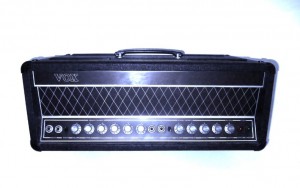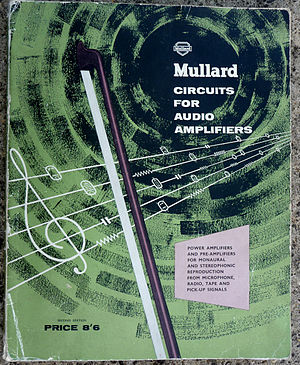Dave Roffey gives us a picture of the kind of research, experimentation and cross-fertilisation that was going on. This wasn’t just with other designers and companies, but with the actual manufacturers and designers of components like the transfomers;
“..Technically, for those times, the design of the valve phase-shift tremolo was an innovation. If that had been worked on, ‘phasing’ would have been around years before it actually appeared. I remember (in the haze of it all) doing a three pot twin t(ee) filter in a foot pedal, which was the closest thing in those days.
Mullard, Brimar and the Williamson KT88 (400W) all contributed to the advances in those days, and some of the guys in their labs might well have inspired designs.”
The valve manufacturer Mullard produced a book, ”Mullard Circuits for Audio Amplifiers”, with template circuits to encourage use of their equipment. These were then adapted by Triumph, Vox and others to their own requirements.
“..At Vamp, when we switched to C core transformers, it was the Brimar guys that helped find a ‘flashover’ issue.
Had to separate the cores in order to reduce the bottom end response. Country guys with tele’s using full bottom and top, could pluck 30Kv spikes along with taking yours eardrums apart.
All an assembly of different sections to fulfil the desired goal.
…The tremolo was that of the valve AC30 I was talking about really. It was a pitch change, rather than modulated volume, albeit a small pitch change. Technically pretty clever for the time. When several circuits like that are put in series, and added to the original signal, the old tape phase is bought about. Interestingly, the first phase units, like Hendrix had, and one I bought out around the same time, used photocells and small bulbs.
…With the advent of semiconductors, and their use in the music industry, there was a kind of explosion of new devices, where virtually every week some new chip would arrive on the market. It used to be great in those days. I remember Dan Armstrong (of the plexiglass guitar fame) could not contain his excitement about a new amp he had designed and told me about his graphic equaliser slider amp. Then ‘bucket brigade’ chips came on the market, linked to the solid state camera chips. They got used for the first solid state echo units. ( A principle explained to Jeff Johnson and myself by two university guys way back in the early days. [Some squatty room in Pimlico market] We both thought that they were nutters as the technology was unbelievably advanced and as we thought would never be achieved. ) Goes to show! Rather like the IBM chairman who couldn’t believe anyone would want table top computers!

Looking at the 715 really takes me back. It’s the aluminium control knobs that does it and the layout of the front panel. Thousands of those knobs. And I remember doing plenty of front panel layouts with the special pcb tape that was used in those days, along with letraset characters. Not sure I remember too many IEC mains sockets around though? More like bulgins as I remember.
I must admit I thought it was Les Avery who designed the tranny stuff at Triumph. His 100 Watt amp was all RCA transistors, hence what I thought was his ‘in’ at RCA. Rock solid amp and so simple, could short that out with a crowbar and the amp would just ping back to life. There was a fabulous guitar strap mounted pre-amp that I thought was his design…. (not) for the sounds that I wanted, but nevertheless, quite an achievement having everything to hand.
Maybe that originated from Thomas? or at least the circuitry. No one wanted small in the early transitional days between valve and tranny. Can’t get a hundred watts out of something the size of a shredded wheat pack was the thought process. HH was the first major breakthrough in that world.
Opto controlled vibe/phase/rolling filter techniques gradually disappeared as the fet appeared and then the mosfet using high frequency pulse modulation, but all were a stepping stone to the ever increasing desire for new effects in those days. I think all designers fed off each other, and each were flattered when their design element were used. There was a good rapport between designers in those days, and very few were ‘utods’ (up their own derrieres). So one was first (got the award), and others added.
It’s quite possible that Dick Denney came up to Triumph to see what was happening or what could get him closer to what he wanted to achieve. There were so many trials with everything in those days. I recall Denney mixing iron filings in an oil mix drum with recording heads. The imagination takes you to all sorts of places.”
“..Dick would listen to sound from a prototype breadboard–you can do that with low voltage circuits. Components in space, connected by the component leads!–and I would adjust on the fly. When he was satisfied, I would design the PC. There was always an emphasis on “brilliance” achieved by high frequency peaking, but not too high in frequency as many of the performers had damaged their HF receptors! Echo was two ceramic cartridges connected via a spring. Tension and length determined delay. Tremolo was wide range, and almost 100% modulation depth at max. There was always the “Transistor” versus “Tube” sound discussions that could not be easily measured, but were certainly perceived. Fuzz was the rage, and certainly helped the long sustain that Dick was looking for.”
